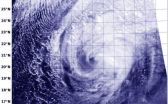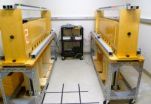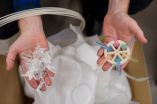(Press-News.org) Johns Hopkins researchers say they have found one way that a recently discovered genetic mutation might cause two nasty nervous system diseases. While the affected gene may build up toxic RNA and not make enough protein, the researchers report, the root of the problem seems to be snarls of defective genetic material created at the mutation site.
The research team, led by Jiou Wang, Ph.D., an assistant professor of biochemistry and molecular biology and neuroscience at the Johns Hopkins University School of Medicine, reports its finding March 5 on the journal Nature's website.
Two years ago, researchers linked the gene C9orf72, named for its location on the ninth human chromosome, to amyotrophic lateral sclerosis (ALS), commonly known as Lou Gehrig's disease, and to frontotemporal dementia (FTD).
In ALS, motor neurons — nerve cells that carry messages from the brain to muscles — degenerate and eventually die, which gradually paralyzes the patient. In FTD, neurons in the frontal and temporal lobes of the brain die. Some scientists think the same genetic and biological processes cause both disorders, but with very different symptoms, depending on where in the brain they occur.
The mutation in C9orf72 is called a hexanucleotide repeat expansion, a six-letter "word" of DNA repeated over and over, in a part of the gene that doesn't contain instructions for making any proteins. Although it's normal to have up to 20 such repeats, some people with ALS or FTD have dozens or even hundreds of them. Studies show the mutation is likely responsible for 4 to 8 percent of cases of sporadic ALS — the kind that isn't necessarily hereditary — and, in some groups, up to 40 percent of the kind that is.
To learn how the repeated sequence causes disease, the Johns Hopkins scientists looked at the structure of the DNA that makes up the gene and the RNA that carries its instructions. Although DNA and RNA are generally seen as long strands, they can bunch and curl to make 3-D structures.
Working with DNA and RNA they made that bore the six-letter "word" repeat, the researchers figured out that both were forming structures called G-quadruplexes. In these formations, guanines — called "G" for short, one of the letters in the repeating DNA "word" — link up, making stacks that stick together like tiny shelves. The RNA also forms other shapes in the repeating section — hairpins and bulges. The researchers speculate that the G-quadruplexes and other structures might be getting in the way of the nucleic acids' normal functions.
The researchers also found that when the cell is making a new strand of RNA based on the C9orf72 gene, it often fails partway through, filling the cell nucleus with pieces of RNA that don't work.
Wang and his colleagues say the broken, clumped RNA molecules appear to be the villains in the diseases caused by the repeated DNA. They counted the proteins that bind to the "bad" RNA and came up with a list of 288 different proteins that are stuck to RNA and are not doing their normal jobs.
One of the proteins that binds to the bad RNA is nucleolin, a protein involved in making ribosomes, which build proteins. The researchers found that in brain cells from healthy people, nucleolin was in the part of the cell nucleus where it should be, where ribosomes are made. But in cells from people with ALS, the nucleolin was scattered all over the nucleus. This suggests that the repeats may also be sabotaging the important functions played by RNA-binding proteins such as nucleolin, Wang says.
It's still possible that C9orf72's product — the protein it codes for — will turn out to be important. "It could be simultaneous — bad RNA accumulating, plus you're losing some of the protein itself," Wang says. But, he says, this study shed light on how the gene affects both RNA and protein and causes disease.
"The findings described in Dr. Wang's paper open up a new pathogenic mechanism for ALS and FTD by providing insight into the biology associated with the C9orf72 mutation and identifying a potential path forward for therapy development," says Margaret Sutherland, Ph.D., program director at the National Institute of Neurological Disorders and Stroke, one of the study's funders.
INFORMATION:
Other authors on the paper were Aaron R. Haeusler, Christopher J. Donnelly, Goran Periz, Eric A.J. Simko, Patrick G. Shaw, Min-Sik Kim, Nicholas J. Maragakis, Juan C. Troncoso, Akhilesh Pandey, Rita Sattler and Jeffrey D. Rothstein, all of The Johns Hopkins University.
This work was supported by the National Institute of Neurological Disorders and Stroke (grant numbers NS07432 and NS085207), the Robert Packard Center for ALS Research at Johns Hopkins, the Muscular Dystrophy Association, Target ALS, the ALS Association, the National Institute on Aging (grant number P50AG05146), the National Cancer Institute (training grant 5T32CA009110-36), the Maryland Stem Cell Research Fund, the Judith and Jean Pape Adams Charitable Foundation and the Samuel I. Newhouse Foundation.
Related stories:
'Individualized' Therapy for the Brain Targets Specific Gene Mutations Causing Dementia and ALS
New Genetic Mutation for ALS Identified
Tracking the True Culprit Behind ALS
ALS-linked gene causes disease by changing genetic material's shape
Unusual process may also explain some dementias
2014-03-05
ELSE PRESS RELEASES FROM THIS DATE:
Study aims to define risk factors for falls in post-menopausal women
2014-03-05
ROSEMONT, Ill.–A new study appearing in the March issue of the Journal of Bone and Joint Surgery (JBJS) showed that women with distal radius (wrist) fractures had decreased strength compared to similar patients without fractures. This could explain why these women were more likely to fall and might sustain future fractures.
The investigators used a variety of balance and strength tests combined with patient-provided information about walking habits to evaluate the physical performance and risk of falls for post-menopausal women with and without previous wrist fractures. ...
UF researchers find drug therapy that could eventually reverse memory decline in seniors
2014-03-05
GAINESVILLE, Fla. — It may seem normal: As we age, we misplace car keys, or can't remember a name we just learned or a meal we just ordered. But University of Florida researchers say memory trouble doesn't have to be inevitable, and they've found a drug therapy that could potentially reverse this type of memory decline.
The drug can't yet be used in humans, but the researchers are pursuing compounds that could someday help the population of aging adults who don't have Alzheimer's or other dementias but still have trouble remembering day-to-day items. Their findings will ...
NASA sees Tropical Cyclone Faxai stretching out
2014-03-05
When a tropical cyclone becomes elongated it is a sign the storm is weakening. Imagery from NASA-NOAA's Suomi NPP satellite today revealed that wind shear was stretching out Tropical Cyclone Faxai and the storm was waning.
On March 5 at 1500 UTC/10 a.m. EST, Tropical Cyclone Faxai's center was located near 22.5 south and 155.2 east, about 699 nautical miles/804.4 miles/ 1,295 km west-northwest of Wake Island. According to the Joint Typhoon Warning Center or JTWC, Faxai's maximum sustained surface winds dropped to 50 knots/57.5 mph/92.6 kph. Faxai was moving to the northeast ...
UCSB study explores cocaine and the pleasure principle
2014-03-05
(Santa Barbara, Calif.) — On the other side of the cocaine high is the cocaine crash, and understanding how one follows the other can provide insight into the physiological effects of drug abuse. For decades, brain research has focused on the pleasurable effects of cocaine largely by studying the dopamine pathway. But this approach has left many questions unanswered.
So the Behavioral Pharmacology Laboratory (BPL) at UC Santa Barbara decided to take a different approach by examining the motivational systems that induce an animal to seek cocaine in the first place. Their ...
First-ever 3D image created of the structure beneath Sierra Negra volcano
2014-03-05
The Galápagos Islands are home to some of the most active volcanoes in the world, with more than 50 eruptions in the last 200 years. Yet until recently, scientists knew far more about the history of finches, tortoises, and iguanas than of the volcanoes on which these unusual fauna had evolved.
Now research out of the University of Rochester is providing a better picture of the subterranean plumbing system that feeds the Galápagos volcanoes, as well as a major difference with another Pacific Island chain—the Hawaiian Islands. The findings have been published in the Journal ...
Brain circuits multitask to detect, discriminate the outside world
2014-03-05
Imagine driving on a dark road. In the distance you see a single light. As the light approaches it splits into two headlights. That's a car, not a motorcycle, your brain tells you.
A new study found that neural circuits in the brain rapidly multitask between detecting and discriminating sensory input, such as headlights in the distance. That's different from how electronic circuits work, where one circuit performs a very specific task. The brain, the study found, is wired in way that allows a single pathway to perform multiple tasks.
"We showed that circuits in the ...
Similarity breeds proximity in memory, NYU researchers find
2014-03-05
Researchers at New York University have identified the nature of brain activity that allows us to bridge time in our memories. Their findings, which appear in the latest issue of the journal Neuron, offer new insights into the temporal nature of how we store our recollections and may offer a pathway for addressing memory-related afflictions.
"Our memories are known to be 'altered' versions of reality, and how time is altered has not been well understood," said Lila Davachi, an associate professor in NYU's Department of Psychology and Center for Neural Science and the ...
Are bilingual kids more open-minded?
2014-03-05
This news release is available in French. Montreal, March 5, 2014 — There are clear benefits to raising a bilingual child. But could there be some things learning a second language doesn't produce, such as a more open-minded youngster?
New research from Concordia University shows that, like monolingual children, bilingual children prefer to interact with those who speak their mother tongue with a native accent rather than with peers with a foreign accent.
The study, published in the journal Frontiers in Psychology and co-authored by psychology professors Krista ...
Save money and the planet: Turn your old milk jugs into 3D printer filament
2014-03-05
Making your own stuff with a 3D printer is vastly cheaper than what you'd pay for manufactured goods, even factoring in the cost of buying the plastic filament.
Yet, you can drive the cost down even more by making your own filament from old milk jugs. And, while you are patting yourself on the back for saving 99 cents on the dollar, there's a bonus: you can feel warm and fuzzy about preserving the environment.
A study led by Joshua Pearce of Michigan Technological University has shown that making your own plastic 3D printer filament from milk jugs uses less energy—often ...
Seeking quantum-ness: D-Wave chip passes rigorous tests
2014-03-05
With cutting-edge technology, sometimes the first step scientists face is just making sure it actually works as intended.
The USC Viterbi School of Engineering is home to the USC-Lockheed Martin Quantum Computing Center (QCC), a super-cooled, magnetically shielded facility specially built to house the first commercially available quantum computing processors – devices so advanced that there are only two in use outside the Canadian lab where they were built: The first one went to USC and Lockheed Martin, and the second to NASA and Google.
Since USC's facility opened ...
LAST 30 PRESS RELEASES:
Heart-brain connection: international study reveals the role of the vagus nerve in keeping the heart young
Researchers identify Rb1 as a predictive biomarker for a new therapeutic strategy in some breast cancers
Survey reveals ethical gaps slowing AI adoption in pediatric surgery
Stimulant ADHD medications work differently than thought
AI overestimates how smart people are, according to HSE economists
HSE researchers create genome-wide map of quadruplexes
Scientists boost cell "powerhouses" to burn more calories
Automatic label checking: The missing step in making reliable medical AI
Low daily alcohol intake linked to 50% heightened mouth cancer risk in India
American Meteorological Society announces Rick Spinrad as 2026 President-Elect
Biomass-based carbon capture spotlighted in newly released global climate webinar recording
Illuminating invisible nano pollutants: advanced bioimaging tracks the full journey of emerging nanoscale contaminants in living systems
How does age affect recovery from spinal cord injury?
Novel AI tool offers prognosis for patients with head and neck cancer
Fathers’ microplastic exposure tied to their children’s metabolic problems
Research validates laboratory model for studying high-grade serous ovarian cancer
SIR 2026 delivers transformative breakthroughs in minimally invasive medicine to improve patient care
Stem Cell Reports most downloaded papers of 2025 highlight the breadth and impact of stem cell research
Oxford-led study estimates NHS spends around 3% of its primary and secondary care budget on the health impacts of heat and cold in England
A researcher’s long quest leads to a smart composite breakthrough
Urban wild bees act as “microbial sensors” of city health.
New study finds where you live affects recovery after a hip fracture
Forecasting the impact of fully automated vehicle adoption on US road traffic injuries
Alcohol-related hospitalizations from 2016 to 2022
Semaglutide and hospitalizations in patients with obesity and established cardiovascular disease
Researchers ‘listen in’ to embryo-mother interactions during implantation using a culture system replicating the womb lining
How changing your diet could help save the world
How to make AI truly scalable and reliable for real-time traffic assignment?
Beyond fragmented markets: A new framework for efficient and stable ride-pooling
Can shape priors make road perception more reliable for autonomous driving?
[Press-News.org] ALS-linked gene causes disease by changing genetic material's shapeUnusual process may also explain some dementias



